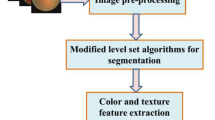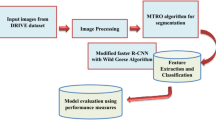Abstract
Aims
Diabetic retinopathy (DR) becomes a complicated type of diabetic that causes damage to the blood vessels of the retina’s light-sensitive tissue. DR may initially cause mild symptoms or no symptoms. But prolonged DR results in permanent vision loss, and hence, it is necessary to detect the DR at an early stage.
Methods
Manual diagnosing of DR retina fundus image is a time-consuming process and sometimes leads to misdiagnosis. The existing DR detection model faces few shortcomings in case of improper detection accuracy, higher loss or error values, high feature dimensionality, not suitable for large datasets, high computational complexity, poor performances, unbalanced and limited number of data points, and so on. As a result, the DR is diagnosed in this paper through four critical phases to tackle the shortcomings. The retinal images are cropped during preprocessing to reduce unwanted noises and redundant data. The images are then segmented using a modified level set algorithm based on pixel characteristics.
Results
Here, an Aquila optimizer is employed in extracting the segmented image. Finally, for optimal classification of DR images, the study proposes a convolutional neural network-oriented sea lion optimization (CNN-SLO) algorithm. Here, the CNN-SLO algorithm classifies the retinal images into five classes (healthy, moderate, mild, proliferative and severe).
Conclusion
The experimental investigation is performed for Kaggle datasets with respect to diverse evaluation measures to deliberate the performances of the proposed system.






Similar content being viewed by others
Availability of data and material
Data sharing is not applicable to this article as no new data were created or analyzed in this study.
Code availability
Not applicable.
References
Faura G, Boix-Lemonche G, Holmeide AK et al (2022) Colorimetric and electrochemical screening for early detection of diabetes mellitus and diabetic retinopathy—application of sensor arrays and machine learning. Sensors 22(3):718
Gupta S, Thakur S, Gupta A (2022) Optimized hybrid machine learning approach for smartphone based diabetic retinopathy detection. Multimed Tools Appl 81(10):14475–14501
Das S, Saha SK (2022) Diabetic retinopathy detection and classification using CNN tuned by genetic algorithm. Multimed Tools Appl 81(6):8007–8020
Lim WX, Chen Z, Ahmed A (2022) The adoption of deep learning interpretability techniques on diabetic retinopathy analysis: a review. Med Biol Eng Comput, pp1–10
Masud M, Alhamid MF, Zhang Y (2022) A convolutional neural network model using weighted loss function to detect diabetic retinopathy. ACM Trans Multimed Comput Commun Appl (TOMM) 18(1):1–16
Elsharkawy M, Sharafeldeen A, Soliman A et al (2022) A novel computer-aided diagnostic system for early detection of diabetic retinopathy using 3D-OCT higher-order spatial appearance model. Diagnostics 12(2):461
Luo X, Pu Z, Xu Y et al (2021) MVDRNet: Multi-view diabetic retinopathy detection by combining DCNNs and attention mechanisms. Pattern Recogn 120:108104
Kalyani G, Janakiramaiah B, Karuna A, Prasad LV (2021) Diabetic retinopathy detection and classification using capsule networks. Complex Intell Syst, pp 1–14
Qureshi I, Ma J, Abbas Q (2021) Diabetic retinopathy detection and stage classification in eye fundus images using active deep learning. Multimed Tools Appl 80(8):11691–11721
Sungheetha A, Sharma R (2021) Design an early detection and classification for diabetic retinopathy by deep feature extraction based convolution neural network. J Trends Comput Sci Smart Technol (TCSST) 3(02):81–94
Bhardwaj C, Jain S, Sood M (2021) Transfer learning-based robust automatic detection system for diabetic retinopathy grading. Neural Comput Appl 33(20):13999–14140
Jadhav AS, Patil PB, Biradar S (2021) Optimal feature selection-based diabetinopathy detection using improved rider optimization algorithm enabled with deep learning
Gadekallu TR, Khare N, Bhattacharya S, Singh S, Maddikunta PKR, Srivastava G (2020) Deep neural networks to predict diabetic retinopathy. J Ambient Intell Humaniz Comput, pp 1–14
Karthikeyan R, Alli P (2018) Feature selection and parameters optimization of support vector machines based on hybrid glowworm swarm optimization for classification of diabetic retinopathy. J Med Syst 42(10):1–11
Taufiqurrahman S, Handayani A, Hermanto BR et al. (2020) Diabetic retinopathy classification using a hybrid and efficient MobileNetV2-SVM model. In 2020 IEEE Region 10 Conference (Tencon) (pp. 235–240). IEEE.Conference (TENCON) (pp 235–240). IEEE
Shankar K, Perumal E, Vidhyavathi RM (2020) Deep neural network with moth search optimization algorithm based detection and classification of diabetic retinopathy images. SN Appl Sci 2(4):1–10
Bodapati JD, Shaik NS, Naralasetti V (2021) Composite deep neural network with the gated-attention mechanism for diabetic retinopathy severity classification. J Ambient Intell Humaniz Comput 12(10):9825–9839
Math L, Fatima R (2021) Adaptive machine learning classification for diabetic retinopathy. Multimedia Tools Appl 80(4):5173–5186
Das S, Kharbanda K, Suchetha M et al (2021) Deep learning architecture based on segmented fundus image features for classification of diabetic retinopathy. Biomed Signal Process Control 68:102600
Sharma A, Shinde S, Shaikh II et al. (2021) Machine learning approach for detection of diabetic retinopathy with improved pre-processing. In 2021 International Conference on Computing, Communication, and Intelligent Systems (ICCCIS) (pp 517–522). IEEE.
Cai LY, Yang Q, Hansen CB et al (2021) PreQual: An automated pipeline for integrated preprocessing and quality assurance of diffusion weighted MRI images. Magn Reson Med 86(1):456–470
Amarapur B (2019) Cognition-based MRI brain tumor segmentation technique using modified level set method. Cogn Technol Work 21(3):357–369
Abualigah L, Yousri D, Abd Elaziz M et al (2021) Aquila optimizer: a novel meta-heuristic optimization algorithm. Comput Ind Eng 157:107250
Desai M, Shah M (2021) An anatomization on breast cancer detection and diagnosis employing multi-layer perceptron neural network (MLP) and Convolutional neural network (CNN). Clinical eHealth 4:1–11
Masadeh R, Alsharman N, Sharieh A et al (2021) Task scheduling on cloud computing based on sea lion optimization algorithm. Int J Web Inf Syst 17(2):99–116
Iglicki M, Busch C, Zur D et al (2019) Dexamethasone implant for diabetic macular edema in naive compared with refractory eyes: the international retina group real-life 24-month multicenter study. IRGREL-DEX Study Retina 39(1):44–51
Iglicki M, Zur D, Busch C et al (2018) Progression of diabetic retinopathy severity after treatment with dexamethasone implant: a 24-month cohort study the ‘DR-Pro-DEX Study.’ Acta Diabetol 55:541–547
Iglicki M, Zur D, Fung A et al (2019) TRActional DIabetic reTInal detachment surgery with co-adjuvant intravitreal dexamethasONe implant: the TRADITION STUDY. Acta Diabetol 56:1141–1147
Iglicki M, Zur D, Negri HP et al (2020) Results in comparison between 30 gauge ultrathin wall and 27 gauge needle in sutureless intraocular lens flanged technique in diabetic patients: 24-month follow-up study. Acta Diabetol 57:1151–1157
Tang F, Luenam P, Ran AR et al (2021) Detection of diabetic retinopathy from ultra-widefield scanning laser ophthalmoscope images: a multicenter deep learning analysis. Ophthalmology Retina 5(11):1097–1106
Funding
Not applicable.
Author information
Authors and Affiliations
Contributions
SVH agreed on the content of the study. SVH and SA collected all the data for analysis. SVH agreed on the methodology. SVH and SA completed the analysis based on agreed steps. Results and conclusions are discussed and written together. Both author read and approved the final manuscript.
Corresponding author
Ethics declarations
Conflict of interest
The authors declare that they have no conflict of interest.
Human and Animal Rights
This article does not contain any studies with human or animal subjects performed by any of the authors.
Informed Consent
Informed consent does not apply as this was a retrospective review with no identifying patient information.
Consent to participate
Not applicable.
Consent for publication
Not applicable.
Additional information
Publisher's Note
Springer Nature remains neutral with regard to jurisdictional claims in published maps and institutional affiliations.
This article belongs to the topical collection Eye Complications of Diabetes, managed by Giuseppe Querques.
Rights and permissions
Springer Nature or its licensor (e.g. a society or other partner) holds exclusive rights to this article under a publishing agreement with the author(s) or other rightsholder(s); author self-archiving of the accepted manuscript version of this article is solely governed by the terms of such publishing agreement and applicable law.
About this article
Cite this article
Hemanth, S.V., Alagarsamy, S. & Dhiliphan Rajkumar, T. Convolutional neural network-based sea lion optimization algorithm for the detection and classification of diabetic retinopathy. Acta Diabetol 60, 1377–1389 (2023). https://doi.org/10.1007/s00592-023-02122-y
Received:
Accepted:
Published:
Issue Date:
DOI: https://doi.org/10.1007/s00592-023-02122-y




